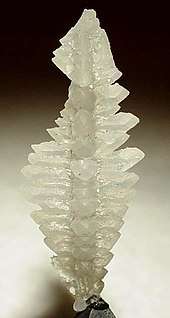Salammoniac
| Sal ammoniac | |
|---|---|
 | |
| General | |
| Category | Halide mineral |
| Formula (repeating unit) | NH4Cl |
| Strunz classification | 3.AA.25 |
| Crystal system | Isometric |
| Crystal class |
Hexoctahedral (m3m) H-M symbol: (4/m 3 2/m) |
| Space group | Pm3m |
| Unit cell | a = 3.859 Å; Z = 1 |
| Identification | |
| Formula mass | 53.49 g/mol |
| Color | Colorless, white, pale gray, may be pale yellow to brown if impure |
| Crystal habit | Crystals skeletal or dendritic; massive, encrustations |
| Twinning | On {111} |
| Cleavage | Imperfect on {111} |
| Fracture | Conchoidal |
| Tenacity | Sectile |
| Mohs scale hardness | 1-2 |
| Luster | Vitreous |
| Streak | White |
| Diaphaneity | Transparent |
| Specific gravity | 1.535 |
| Optical properties | Isotropic |
| Refractive index | n = 1.639 |
| Birefringence | Weak after deformation |
| Ultraviolet fluorescence | no |
| Absorption spectra | no |
| Solubility | in water |
| References | [1][2][3] |

Sal ammoniac or Salammoniac,[1] is a rare naturally occurring mineral composed of ammonium chloride, NH4Cl. It forms colorless, white, or yellow-brown crystals in the isometric-hexoctahedral class. It has very poor cleavage and a brittle to conchoidal fracture. It is quite soft, with a Mohs hardness of 1.5 to 2, and it has a low specific gravity of 1.5. It is water-soluble. Sal ammoniac is also the archaic name for the chemical compound ammonium chloride.
The Romans called the ammonium chloride deposits that they collected from near the Temple of Jupiter Amun (Greek Ἄμμων Ammon) in ancient Libya 'sal ammoniacus' (salt of Amun) because of proximity to the nearby temple.[4] Salts of ammonia have been known from very early times; the term Hammoniacus sal appears in the writings of Pliny,[5] but it is not known whether the term is identical with the more modern sal-ammoniac.[6] In any case, that salt ultimately gave ammonia and ammonium compounds their name.
It typically forms as encrustations formed by sublimation around volcanic vents and is found around volcanic fumaroles, guano deposits and burning coal seams. Associated minerals include sodium alum, native sulfur and other fumarole minerals. Notable occurrences include Tajikistan; Mount Vesuvius, Italy; and Parícutin, Michoacan, Mexico.
Uses
It is commonly used to clean the soldering iron in the soldering of stained-glass windows. In jewellery-making and the refining of precious metals, potassium carbonate is added to gold and silver in a borax-coated crucible to purify iron or steel filings that may have contaminated the scrap. It is then air-cooled and remelted with a one-to-one mixture of powdered charcoal and sal ammoniac to yield a sturdy ingot of the respective metal or alloy in the case of sterling silver (7.5% copper) or karated gold.
Sal ammoniac has also been used in the past in bakery products to give cookies or biscuits their crisp texture, but the application of food grade baking ammonia (ammonium carbonate) is generally being substituted with the creation of modern baking powder or baking soda (sodium bicarbonate). Sal ammoniac is known, inter alia, by its use in salmiac liquorice, for instance salty liquorice or salmiak pastilles. In addition, the mineral or better its synthetic counterpart also serves for the production of cooling baths as well as in the dyeing and leather tanning (see also use of ammonium chloride).[7]
Sal ammoniac (ammonium chloride) was the electrolyte in Leclanche cells, a forerunner of the dry battery; a carbon rod and a zinc rod or cylinder formed the electrodes.
References
- 1 2 "Salammoniac". mindat.org and the Hudson Institute of Mineralogy.
- ↑ "Redirect for Sal-ammoniac". webmineral.com.
- ↑ "Handbook of Mineralogy" (PDF).
- ↑ "Ammonia". h2g2 Eponyms. BBC.CO.UK. 2003-01-11. Retrieved 2007-11-08.
- ↑ Chisholm 1911 cites Pliny Nat. Hist. xxxi. 39
- ↑ "Sal-ammoniac". Webmineral. Retrieved 2009-07-07.
- ↑ "In Salmiak Territory - Opinion - The Harvard Crimson". www.thecrimson.com.
External links

- Mineral galleries